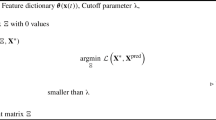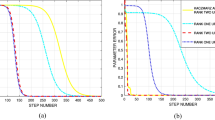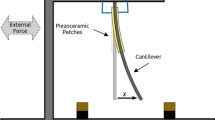Abstract
In this paper, a novel approach is proposed to identify the cascade of Hammerstein model by using Volterra series analytical method. The cascade of Hammerstein model consists of power series associated with linear subsystems. The relationship between the cascade of Hammerstein model and its associated Volterra model is firstly presented in this paper. The basic routine of the identification approach is that, from the system outputs under multilevel excitations, the Volterra series outputs of different order are first estimated by using the wavelet balance method. Then, through each order Volterra outputs and input, the impulse response functions of each order linear subsystems can be estimated, respectively. The simulation studies verify the effectiveness of the proposed identification method for the cascade of Hammerstein model.













Similar content being viewed by others
References
Chen, S., Billings, S.A.: Representations of non-linear systems: the NARMAX model. Int. J. Control 49, 1013–1032 (1989)
Peng, Z.K., Lang, Z.Q., Wolters, C., et al.: Feasibility study of structural damage detection using NARMAX modelling and nonlinear output frequency response function based analysis. Mech. Syst. Signal Process. 25, 1045–1061 (2011)
Guo, Y.Z., Guo, L.Z., Billings, S.A., et al.: Volterra series approximation of a class of nonlinear dynamical systems using the Adomian decomposition method. Nonlinear Dyn. 74, 359–371 (2013)
Sigrist, Z., Grivel, E., Alcoverro, B.: Estimating second-order Volterra system parameters from noisy measurements based on an LMS variant or an errors-in-variables method. Signal Process. 92, 1010–1020 (2012)
Hsu, C.F.: Nonlinear system control using a self-organizing functional-linked neuro-fuzzy network. Nonlinear Dyn. 73, 1631–1643 (2013)
Mushage, B.O., Chedjou, J.C., Kyamakya, K.: An extended Neuro-Fuzzy-based robust adaptive sliding mode controller for linearizable systems and its application on a new chaotic system. Nonlinear Dyn. 83, 1601–1619 (2016)
Cai, Z., Bai, E.W.: Making parametric Hammerstein system identification a linear problem. Automatica 47, 1806–1812 (2011)
Umoh, I.J., Ogunfunmi, T.: An affine projection- based algorithm for identification of nonlinear Hammerstein systems. Signal Process. 90, 2020–2030 (2010)
Yu, F., Mao, Z., Jia, M., et al.: Recursive parameter identification of Hammerstein-Wiener systems with measurement noise. Signal Process. 105, 137–147 (2014)
Schetzen, M.: The Volterra and Wiener Theories of Nonlinear Systems. Wiley, New York (1980)
Rugh, W.J.: Nonlinear System Theory: The Volterra-Wiener Approach. Johns Hopkins University Press, Baltimore (1980)
Billings, S.A., Lang, Z.Q.: Non-linear systems in the frequency domain: energy transfer filters. Int. J. Control 75, 1066–1081 (2002)
Li, P., Wei, H.L., Billings, S.A.: Nonlinear model identification from multiple data sets using an orthogonal forward search algorithm. J. Comput. Nonlinear Dyn. 8, 041001 (2013)
Ogunfunmi, T.: Adaptive Nonlinear System Identification: The Volterra and Wiener Model Approaches. Springer, New York (2007)
Silva, W.: Identification of nonlinear aeroelastic systems based on the Volterra theory: progress and opportunities. Nonlinear Dyn. 39, 25–62 (2005)
Chen, Y., Hunter, I.W.: Nonlinear stochastic system identification of skin using volterra kernels. Ann. Biomed. Eng. 41, 847–862 (2013)
Contan, C., Kirei, B.S., Topa, M.D.: Modified NLMF adaptation of Volterra filters used for nonlinear acoustic echo cancellation. Signal Process. 93, 1152–1161 (2013)
Liu, J., Zhang, Y., Yun, B.: A new method for predicting nonlinear structural vibrations induced by ground impact loading. J. Sound Vib. 331, 2129–2140 (2012)
Tawfiq, I., Vinh, T.: Nonlinear behaviour of structures using the Volterra series-signal processing and testing methods. Nonlinear Dyn. 37, 129–149 (2004)
Boyd, S., Chua, L.O.: Fading memory and the problem of approximating nonlinear operators with Volterra series. IEEE Trans. Circuits Syst. CAS–32, 1150–1161 (1985)
Korenberg, M.J.: Parallel cascade identification and kernel estimation for nonlinear systems. Ann. Biomed. Eng. 19, 429–455 (1991)
Tiels, K., Schoukens, J.: Wiener system identication with generalized orthonormal basis functions. Automatica 50, 3147–3154 (2014)
Schoukens, J., Pintelon, R., Rolain, Y., et al.: Structure discrimination in block-oriented models using linear approximations: a theoretic framework. Automatica 53, 225–234 (2015)
Gomez, J.C., Baeyens, E.: Identification of block-oriented nonlinear systems using orthonormal bases. J. Process Control 14, 685–697 (2004)
Zeng, J., Baldelli, D.H., Brenner, M.: Identification of nonlinear Hammerstein system using orthonormal bases: application to nonlinear aeroelastic /aeroservoelastic system. J. Guid. Control Dyn. 31, 1677–1686 (2008)
Novak, A., Maillou, B., Lotton, P., et al.: Nonparametric identification of nonlinear systems in series. IEEE Trans. Instrum. Meas. 63, 2044–2051 (2014)
Novak, A., Simon, L., Kadlec, F., et al.: Nonlinear system identification using exponential swept-sine signal. IEEE Trans. Instrum. Meas. 59, 2220–2229 (2010)
Farina, A.: Simultaneous measurement of impulse response and distortion with a swept-sine technique. In: 108th Convention of the Audio Engineering Society (2000)
Farina, A., Bellini, A., Armelloni, E.: Non-linear convolution: a new approach for the auralization of distorting systems. In: 110th Convention of Audio Engineering Society (2001)
Rébillat, M., Hennequin, R., Corteel, É., et al.: Identification of cascade of Hammerstein models for the description of nonlinearities in vibrating devices. J. Sound Vib. 330, 1018–1038 (2011)
Rébillat, M., Hajrya, R., Mechbal, N.: Nonlinear structural damage detection based on cascade of Hammerstein models. Mech. Syst. Signal Process. 48, 247–259 (2014)
Cheng, C.M., Peng, Z.K., Zhang, W.M., et al.: Wavelet basis expansion-based Volterra kernel function identification through multilevel excitations. Nonlinear Dyn. 76, 985–999 (2014)
Cheng, C.M., Dong, X.J., Peng, Z.K., Zhang, W.M., et al.: Wavelet basis expansion-based spatio-temporal Volterra kernels identification for nonlinear distributed parameter systems. Nonlinear Dyn. 78, 1179–1192 (2014)
Lang, Z.Q., Billings, S.A.: Energy transfer properties of non-linear systems in the frequency domain. Int. J. Control 78, 345–362 (2005)
Li, X., Hu, B., Ling, X.: A wavelet-balance approach for steady-state analysis of nonlinear circuits. IEEE Trans. Circuits Syst. I Fundam. Theory Appl 49, 689–694 (2002)
Pernot, S., Lamarque, C.H.: A wavelet-balance method to investigate the vibrations of nonlinear dynamical systems. Nonlinear Dyn. 32, 33–70 (2003)
Ljung, L.: System Identification: Theory for the User. Preniice Hall Inf and System Sciencess Series, New Jersey (1987)
Shang, Y.: Consensus of noisy multiagent systems with markovian switching topologies and time-varying delays. Math. Probl. Eng. 2015, 453072 (2015)
Shang, Y.: Group consensus of multi-agent systems in directed networks with noises and time delays. Int. J. Syst. Sci. 46, 2481–2492 (2015)
Shang, Y.: Synchronization in networks of coupled harmonic oscillators with stochastic perturbation and time delays. Ann. Acad. Rom. Sci. Ser. Math. Appl. 4, 44–58 (2012)
Acknowledgments
The work reported in this paper was supported by the Chinese Natural Science Foundation projects with the reference number of 11472170, 51421092 and 11402144 and the STCSM fund (14140711100) and the Chinese Distinguished Young Scholars project No. 11125209 and the China Postdoctoral Science Foundation project 15005188.
Author information
Authors and Affiliations
Corresponding author
Rights and permissions
About this article
Cite this article
Cheng, C.M., Peng, Z.K., Zhang, W.M. et al. A novel approach for identification of cascade of Hammerstein model. Nonlinear Dyn 86, 513–522 (2016). https://doi.org/10.1007/s11071-016-2904-0
Received:
Accepted:
Published:
Issue Date:
DOI: https://doi.org/10.1007/s11071-016-2904-0




